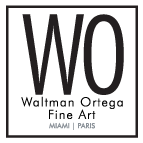Stevens Dossou-Yovo’s practive investigates not only the question of temporality but also the relationship between space and matter. At the junction between a metaphysical vision of our world and the mere materiality of the object, his sculptures, often meant to be hung on a wall, are like metaphors of the reality. « It all starts in the virtual but the most certain completion resides in the physical object», the artist says.
Indeed, his art connects a variety or routes « I use the metaphysical vocabulary to create my own vision of the 3rd dimension based on the 2nd». Stevens Dossou-Yovo’s initial steps comprise numerous graphite drawings as a way to better project an idea in volume. This is the very moment when the spectator goes from the virtual to the real.
The rectangle is his madeleine of Proust. Used like an alphabet, it defines space and our own perception of it. The void one can see inside the sculptures speaks about a suspended time. In addition, Stevens Dossou-Yovo explores the various textures that steel can offer: oxidized, brushed or painted, the patina of these floating shapes remind us of the passing time. His sculptures can be seen as purely abstract charts but also as inner landscapes. The geometry and perspective have always been at the very core of his creation and ultimately open an infinity of mental possibilities.
Stevens Dossou-Yovo admits to pursue a quest a quest of universality: the language and mathematics all the more nourish his art as they belong to everyone and no one at the same time, through centuries, cultures and beliefs as well.
Stevens Dossou-Yovo’s sculptures are spatial equations, metaphorically speaking. Math formulas, even. Like Alexander Calder’s stabiles, the optical illusion creates an astonishing effect of immobile movement. The elements seem to be falling and levitating at the same time, animated by the circulation of the air. It’s like offering a new way to envision the materiality of the world that surrounds us.
Olivier Waltman
Paris, 2022
Stevens was born in Paris, where he later graduated from the Penninghen design school. He dedicated himself metal sculpture and was soon producing anthropomorphic sculptures and automata. In recent years, Stevens has moved away from figurative sculpture; he now focuses on the representation of space through powerful mural compositions. Steel remains his favourite medium: a fairly basic material, it lends itself to all sorts of experimentation. Stevens says he derives inspiration from the sky. It is no coincidence that his studio should be suspended in mid-air, commanding an impressive view over the Paris skyline It is a confined space with a large bay window open to the horizon, recalling a camera obscura in which the artist condenses and refracts the outside world. Stevens’ geometrical compositions give form to an inner vision. They are poised between the weightlessness of a mental picture and the gravity of the metal. The resulting tension even hints at a metaphysical dimension. Indeed, Stevens says that the play on optical illusion in his work reflects his questioning of the origins and confines of reality. His work is the result of his quest for some kind of order. In the artist’s studio, archaeology meets spatial exploration: “I probe, I excavate”, he says. “Working is a way for me to get closer to what I’m looking for”. Thus each sculpture leads naturally to another, and so the vision renews itself, becoming more acute in the process. With his Broken Clouds series, Stevens believes he is getting closer to his ultimate goal. The work on volume and perspective he has pursued over the years here shows an unprecedented degree of mastery.
Each sculpture offers up a spatial equation, a mathematical formula. Each combines the principles of concentration and expansion: the optical illusion is the result of a process whereby the tension between opposing forces is cancelled out, producing a striking impression of suspended motion. The assembled elements seem to be both in free-fall and levitating, both static and animated by the flow of air or the pull of gravity. Broken Clouds is thus an invitation to gaze into virtual skies and the expanding universe. The structures holding the elements together are carefully concealed, so that each composition seems to be floating. The metal is given a different surface treatment, depending on the final effect intended. In some cases, the metal is left raw while certain areas are polished; the colour and texture of the metal are subtly altered, as is the way it absorbs or reflects the light. Elsewhere, Stevens applies acid to certain surfaces in order to add depth and tone. An additional illusion is thereby produced: in those compositions where some of the facets are oxidized, the metal seems to have morphed into another material. Some sculptures take the illusion even further. In those whose surface is painted uniformly white, the resulting impression is one of weightlessness and stillness, verging on dematerialisation: here the metal becomes an invisible and abstract expression of volume, space and movement. A more recent development in Stevens’ work is the inclusion of photography. A keen sky-gazer, he has captured various cloudscapes with his camera and built a picture library.
Depending on the mood and tone of the composition he has in mind, he selects an image and has it digitally printed. He then applies fragments of the print onto the metal surface, turning the steel into a lens reflecting a virtual sky. Broken Clouds exists, then, at the junction between outside and inside, between the actual and the virtual. It is an invitation to stand still and watch the expanding universe.
Blandine Chambost
Paris, 2013
